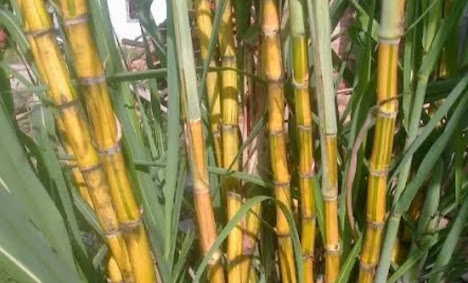Sugarcane (Saccharum sp. hybrids) is a highly productive C4 grass used as the main source
of sugar and more recently to produce ethanol, a renewable transportation fuel.
Cane sugar first achieved dominance on the subcontinent of India more than 2500 years ago, and it was in that country and China that commercial sugar was first produced from sugarcane.
It was not until the early eighteenth century, however, that sugar began to become widely used in western Europe.
Commercial sugarcane is grown as a source of sugar (sucrose) for human food. By-products from processing sugarcane into sugar such as molasses and bagasse have been mainly used as additives in stockfeed.
Sugar cane is a tropical crop requiring a hot climate. However, it also grows well in a subtropical climate. It has wider adaptability and grows well where the temperature ranges between 20 and 35 °C. It responds well to a long period of sunlight (12 to 14 hours). High humidity (80–85 %) favours rapid cane elongation during the main growth period.
Sucrose is the primary product of plant photosynthesis and, therefore, common in food crops consumed regularly by humans and animals.
Sugarcane also contains cyanogenic glucosides. These can be cleaved to produce hydrocyanic acid, a poison that acts by inhibiting cytochrome oxidase, thus preventing transfer of oxygen from the blood to the tissues. It is present in many plants, including sugarcane, where it is not at a dangerous level for humans.
Sugar not only enhances the flavors of food and intensifies its color, but it also has other properties, e.g. it can be used as a preservative or as a substrate for fermentation, and it is also a source of energy. Consequently, it is a very useful commodity.
Sugar cane – tropical crop from which sugar is processed
What makes soft drinks so noteworthy is that, despite not being essential, their consumption continues to rise. They are entirely human inventions—both as a product and as a market. In fact, soft drinks were among the first branded goods to achieve truly global reach.
The Most Popular Posts
-
Most sweet drinks, including diet soft drinks, contain orthophosphoric, carbonic and citric acids; malic, tartaric and other organic acids m...
-
Charles George Guth (June 3, 1877 – May 24, 1948) was an American businessman. Guth apparently had spent most of his life prior to th...
-
Soft drinks rely heavily on colorings to create an appealing appearance, significantly influencing consumer preferences. The color of a drin...
-
Soft drinks have become an integral part of modern diets, with three main areas of nutritional focus driving their formulation: energy deliv...
-
Birch beer, a distinctive beverage with a rich history, traces its origins to North America. Native American tribes were the first to recogn...
